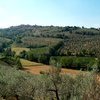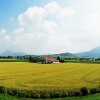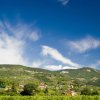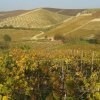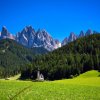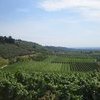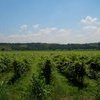Euganean Hills: the Park, the Villas and the Cellars
Departure from: Cervarese Santa Croce
Arrival to: Abano Terme
What you can taste:
Colli Euganei Bianco, Colli Euganei Cabernet, Colli Euganei Cabernet Franc, Colli Euganei Cabernet Sauvignon, Colli Euganei Chardonnay, Colli Euganei Fior d'Arancio passito, Colli Euganei Fior d'Arancio Spumante, Colli Euganei Merlot, Colli Euganei Moscato, Colli Euganei Pinello, Colli Euganei Pinot Bianco, Colli Euganei Rosso, Colli Euganei Serprino, Colli Euganei Tai
Itinerary details
The Euganean Hills, a group of reliefs of volcanic origin, arise on the central Venetian plain, a few kilometers south-west of Padua, almost unexpectedly and isolated, as if they were almost an archipelago.
The English geologist John Strange, in fact, around 1770, defined them exactly like this: "they stand isolated, like rocks in the sea". From whichever direction you arrive, in fact, these hills amaze with their sudden "soaring" over the "sea" of the Po valley, with their particular geometric profile: the hills, almost perfectly conical, have isolated peaks, alternating with gently rounded slopes.
The Euganean Hills are an area rich in nature, art, history, food and wine and well-being.
The unmistakable geometry of the landscape, with the conical shape that refers to the antiquity of the volcanic origins, to the eruptions of 40 million years ago, the uniqueness of the natural environments, but also the richness of the artistic, historical and cultural heritage make the Euganean Hills a place to visit in its entirety.
Here, we will find enchanting corners of uncontaminated nature and a precious heritage of biodiversity; in fact, the first Regional Park of the Veneto was born on the Euganean Hills and there are therefore numerous sites of naturalistic interest, in which over 1400 botanical species are concentrated.
The Euganean Hills are an ideal green world for those who love walking, surrounded by nature, but also for cycling enthusiasts.
The ring of the Euganean Hills, in fact, is a cycling itinerary that develops around the Regional Park, crossing small inhabited centers and developing over about 60 km; the route, E2, can be covered in a day, or two, if you want to stop and visit the places of interest; it runs alongside several waterways, is almost completely flat and the only slope, which is quite light, is located near Bastia.
Among woods, hills, vineyards, olive groves, the heritage of the Euganean Hills is enriched with monuments, such as villas, castles, abbeys and historic villages.
Immersed in the Euganean Hills, an area of 15 municipalities, in fact, 15 wonderful villages stand out, where nature and history meet.
The interesting historical monuments, witnesses of the richness and importance of the artistic heritage of the Euganean territory, offer the possibility of admiring sculptural and architectural works of immense value.
There are also numerous archaeological finds that will allow you to learn about the ancient history of the place.
The Euganean hills, for their beauty, have also inspired important writers, poets and artists, Petrarca and Foscolo, first of all, who, over time, have left priceless works in these places.
One cannot help but be enchanted by the imposing castles and the fascinating and sumptuous villas, belonging to noble Venetian and Paduan families.
Between nature and food and wine
Furthermore, the Euganean Hills also offer the possibility of making food and wine itineraries, in the name of the food and wine excellences and culinary specialties of the place.
The farmhouses, restaurants and trattorias also offer the possibility of tasting high quality local products, now recognized all over the world and traditional dishes of peasant cuisine.
The Euganean Hills are famous for the production of excellent wine and, in fact, are located in an area between the 40th and 50th parallel, close to the 45th, defined as the "wine parallel", due to the equidistance between from the North Pole and the Equator, in an area that acts as a watershed, therefore, between the too cold of the North and the too hot of the South.
The Euganean Hills, due to the favorable climate and the particular morphology of the place, produce wines with an inebriating aroma and unmistakable flavour.
The numerous wineries of the Euganean Hills give life to excellent wines, including many labels awarded with prestigious awards and certified denominations.
Among the excellences, the Fior d'Arancio DOCG stands out, but the range of white and red wines is truly vast and is able to amaze even the most demanding connoisseurs.
Rosso dei Colli Euganei, Cabernet Sauvignon, Merlot, Raboso, Marzemino, Corbinello and Novello, and then, Bianco dei Colli Euganei, Moscato, Serprino, Pinot Bianco, Chardonnay, Tocai Italico are just some of the excellence of the area.
In addition to direct sales, the cellars offer guided tastings and visits to their companies, offering the opportunity to get to know the wine production up close.
We therefore propose a visit to the Az. Agr. Bacchus and Ariadne and Venda Park in Vò, Giacomo Salmaso in Montegrotto, Il Pianzio in Galzignano Terme, Callegaro Francesca in Rovolon, Filò delle Vigne in Baone, Cà Lustra and Fattoria Monte Fasolo in Cinto Euganeo and at Cantine Bernardi in Torreglia.
For those who love organic wines, a tour of the Fattoria Eolia in Rovolon is a must.
In the hamlet of Faedo, in Cinto Euganeo, among vineyards and olive trees, is the Podere Villa Alessi, a renowned winery, a space where the food and wine tradition marries with the gentle hilly landscape. Here, you can spend moments of tranquility, tasting fine wines, exquisite typical products and dishes prepared with care according to ancient local recipes. However, a visit to the Bottaia Museo is a must, a basement room which, for years, was used to store the best wine in small oak barrels and which, today, is a museum that allows you to learn a little about geology of the Euganean Hills and to savor the charm of the local wine.
The Euganean Hills, however, are also famous for their high quality honey, included in the list of traditional products according to the directives of the Ministry of Agricultural and Forestry Policies.
The introduction of the olive tree in the Euganean Hills took place in very distant times, some sources even say in pre-Roman times and, today, four native crops survive which produce excellent oil, according to ancient traditions.
Arquà Petrarca is renowned for its excellent olive oil which has also allowed it to join the National Association of Oil Cities and become a prestigious destination for food and wine tourism of the highest quality.
The southern area of the Euganean Hills, between Baone and Arquà Petrarca, however, is particularly known for the cultivation of peas, the so-called "bisi", and the "Festa dei Bisi" is held every year in Baone.
Another well-known product is cherries, cultivated in almost the entire Euganean area for centuries now, one of the most characteristic products of the Park, so much so that they also offer an annual festival: the Cherry Festival. Therefore, a taste of the famous "Maraschino" liqueur is a must.
On the Euganean Hills, the jujube is also grown, an elegant small tree of medium height, with characteristic similar fruits, in the shape of olives, and in flavor to the apple. A festival is also dedicated to the jujubes which is held on the first and second Sunday of October, in Arquà Petrarca, where, in addition to the jams, you can taste the typical liqueur: "Il broth of Giuggiole"
Places of historic-artistic interest
Our historical-artistic and naturalistic itinerary on the Euganean Hills starts from Cervarese, a village with very distant origins, with a long story to tell and with numerous natural and architectural beauties to show.
We can visit the Medieval Castle of San Martino, whose imposing tower was erected in the Lombard age and which now houses the Bacchiglione River Museum.
Continuing in the direction of Vò, a municipality located on the western slope of the Euganean Hills, along Monte Venda, considered the highest in the area, we then find Lozzo Atestino, where the Castello di Valbona stands, perfectly preserved in its fourteenth-century forms and which, currently, it houses a renowned restaurant.
In Teolo, on the other hand, a little further on, the Praglia Abbey is interesting, a Benedictine monastery located at the foot of Monte Lonzina and which currently houses the National Library.
In Cinto Euganeo, in the immediate vicinity, a small town with ancient Roman origins, a visit to the Buso della Casara which contains the remains of the extraordinary Roman aqueduct is a must.
Another important attraction is located in Cinto Euganeo: the Cava Bomba complex, a former furnace used in the 19th century for the extraction and production of lime and which today marks the starting point of the Monte Cinto path and it is the seat of the Geopaleontological Museum.
Continuing, we find Este, in the heart of the Euganean Hills Regional Park, an important walled city and land of ceramics, a village with a long history, testified by the archaeological finds now preserved in the Museo Nazionale Atestino. A visit to the Cathedral of Santa Tecla is also a must, where a large painting by Giambattista Tiepolo is kept.
A little further on, in Baone, a quiet town, we find Villa Beatrice d'Este, located on Monte Gemola, a splendid panoramic point, from where, on the clearest days, you can even see the bell tower of San Marco. Currently, some rooms of the villa are used as headquarters of the Naturalistic Museum, in whose rooms the vegetational and faunal aspects of the Euganean territory are illustrated.
Continuing, in Monselice, Villa Pisani stands out, a Venetian villa and prestigious venue for events and exhibitions and the ancient medieval castle Castello Cini, owned by the Veneto Region, which has destined it for museum purposes. Inside the complex, in fact, there is the seat of the Longobard Antiquarium and the Museum of Rarities. Also worth mentioning are the Villa Duodo architectural complex, a Venetian villa located halfway up the hill of Colle della Rocca, which can only be visited externally, and the Mastio Federiciano, located on the top of Colle della Rocca.
Making a small detour towards Arquà Petrarca, whose fame is due to the figure of the famous poet, whose home and funeral monument we find, we can visit one of the most beautiful medieval villages in Italy.
Continuing on, we arrive at Battaglia Terme, the smallest town in the province of Padua, whose historic centre, overlooking the canals, makes it look like a coastal resort. Battaglia Terme, a town known and appreciated for its spas, together with the cities of Abano, Montegrotto and Galzignano, owes its importance to the only natural thermal cave in the Euganean area
In Galzignano, precisely, a place of relaxation between spas and gardens, between the valleys enclosed between Monte Rua and Monte Gallo, we find luxurious hotel facilities that offer the most modern spa treatments.
There are numerous villas to admire but, first of all, Villa Barbarigo Pizzoni Ardemani, renowned for its extraordinary Baroque garden, a park full of fountains, sculptures and centuries-old trees.
Still in Galzignano it is also possible to visit the River Navigation Museum and the Catajo Castle. Furthermore, in Sottovenda, from Casa Marina, it is possible to start the Monte Venda path which, with an easy, circular itinerary, also equipped for the disabled, allows you to enjoy magnificent panoramas, immersed in the chestnut woods and observe some "maronari " historians.
Montegrotto, another municipality in the Euganean Hills, is affirming itself as the most important thermal complex in Europe, whose name refers precisely to the therapeutic use that, since ancient times, has been made of its hot water springs. The town also boasts the first Italian museum of live butterflies, the Butterfly Arc or Casa delle Farfalle which welcomes numerous specimens from all over the world. The International Museum of Art Glass and Thermal Baths is also very interesting, housed in the rustic Villa Draghi. A visit to the San Daniele Monastery, a Benedictine monastery, is also not to be missed, easily accessible thanks to the spacious cycle-pedestrian path at the foot of the hill.
In Torreglia, we find the famous Venetian villa Villa dei Vescovi, declared a national monument and owned by the FAI and the Hermitage of Rua, built on the top of the mountain of the same name, in 1339, which still hosts a small number of Camaldolese friars.
Adjacent to Monte Rua, for those who love to immerse themselves in nature, Monte Venda, located in the municipalities of Teolo, Cinto Euganeo, Galzignano and Vo' is, with its 603 meters, the highest elevation of the Euganean Hills, offering numerous itineraries.
Our long itinerary in the Euganean Hills concludes in Abano Terme, another spa center par excellence.
Umbria • Montefalco
The hills of Sagrantino di Montefalco
Route distance: about 7 km
Suggested travel mode: by Bike
Veneto • Breganze - Bassano
The "Strada del Torcolato e dei vini di Breganze"
Route distance: about 40 km
Suggested travel mode: by Car
Veneto • Euganean Hills
Euganean Hills: the Park, the Villas and the Cellars
Route distance: about 70 km
Suggested travel mode: by Car
Veneto • Valpolicella
Valpolicella: a tour of cellars, museums and villas
Route distance: about 40 km
Suggested travel mode: by Car
Lombardy • the river Po
Visit Casalmaggiore on the trail of the pumpkin
Route distance: about 3km
Suggested travel mode: by Foot
Piedmont • Monferrato Astigiano
Monferrato Astigiano and tradition of Bagna Cauda
Route distance: about 30 km
Suggested travel mode: by Car
South Tyrol • St. Magdalene
Excursion to Val di Funes, tasting Speck Alto Adige
Route distance: about 40km
Suggested travel mode: by Foot
Emilia Romagna • Parma
Langhirano, along the Parma Ham Road
Route distance: about 50km
Suggested travel mode: by Car
Liguria • the coast
The Genoese coast and the Focaccia di Recco
Route distance: about 30 km
Suggested travel mode: by Foot
Lazio • Castelli Romani
Frascati and surroundings
Route distance: about 30km
Suggested travel mode: by Car
Veneto • the Castles
From the Castles of Romeo and Juliet to Soave
Route distance: about 35 km
Suggested travel mode: by Car
Veneto • natural wines
From the Euganean Hills to Montecchio Maggiore
Route distance: about
Suggested travel mode: by Car
Tuscany • Val di Cornia
Val di Cornia, in the footsteps of the Etruscans
Route distance: about 35 km
Suggested travel mode: by Car
Lazio • Colli Albani
The Castelli Romani of the Via Appia
Route distance: about 24 km
Suggested travel mode: by Car

